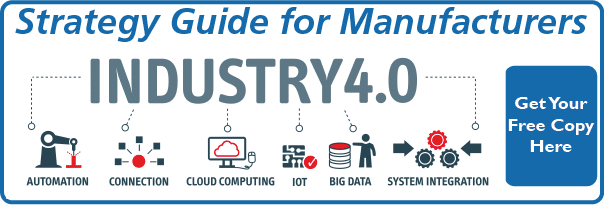What are the threats & opportunities?
Let's put aside hackneyed exhortations like "best defense is a strong offense" and look seriously at the revenue growth landscape for middle market industrial manufacturing firms.
- Brand value is more ephemeral than ever - With very few exceptions (e.g. Boeing, GE, Caterpillar) brand in the industrial space is becoming less important as every transaction becomes easily researched and independently executed. Brand is only important as the cumulative experience that individuals and companies have, and it's retrospective in a world which is increasingly prospective as Manufacturing 4.0 disruptions loom. The claims of established dominance made by many companies, the focus on product, and emphasis on "brand's" aesthetic attributes only distract from real risks/opportunities. While there's some stickiness to operator familiarity for machines, and consolidated spare parts, brand is rapidly losing importance in this space.
- Distribution channels are changing rapidly - Grainger's business is growing quickly, and shifting rapidly to ecommerce (projected to be 80% in five years.) Direct field sales forces and traditional indirect channel, both products of eras when buyers needed sales people to help them obtain information, are no longer inherently necessary. A few are evolving to provide legitimate value, but they are the exception.
- Rising generations of buyers have very different expectations - Management of manufacturing firms are anchored in earlier generations while buyers are accustomed to different norms. There's even significant dissonance between how company management buys and sells. Buying begins long before any vendor is engaged, and the role of sales and marketing have merged in a world where sales are won by providing the most relevant and insightful information, to the right people, at the right time - not by turning a rehearsed manipulative phrase during a meeting. Transparency, some claim, is the next sales system. That means that volume of genuinely helpful, empathetic content, properly optimized and positioned to be found by prospects at all stages of the buying journey, is key to attracting and closing prospects.
- Barriers to competition are falling - Cumulatively these factors mean that threats can easily and quickly arise from not only market risks, but also small competitors. The internet enables any company, with an investment of just a few hundred thousand dollars/year, to achieve levels of awareness and activity which would have required millions, or a powerful brand, just years ago.
- Workforce challenges limit growth - Manufacturing companies face growing workforce constraints, yet they treat those as an education issue. The reality is that companies must market to prospects, current customers, employment candidates, employees, investors & lenders, and community stakeholders. While it's easy to blame schools, attitudes or absence of a German style apprenticeship program, some companies recognize that new generations of employees are "likely to view a company skeptically if its website is outdated or if its social media presence is lacking."
- Manufacturing 4.0 means growing threats and opportunities - The traditional communication, competitive analysis and product innovation/pipeline roles of marketing are critical to gathering the intelligence that will inform the response of companies. A recent HBR article "The Trouble with CMOs" notes that industrial manufacturing firms tend to default to a "Commercialization" marketing function - yet levels of dynamic change in an industry (data & cloud based solutions, subscription business models, IoT, 3D printing....are we dynamic yet??) indicate that at least a "Strategic" and likely a "P&L" marketing function is necessary to collect data and interpret and respond to market expectations.
Case study - how a lower middle market manufacturer outperformed Bosch in just a couple months (read it here)
Taken together there's a lot to consider. In short:
- Existing companies face threats from competitors, market changes and buyer expectations
- All companies, regardless of age, size or "brand" strength can leapfrog competitors of all sizes, or just as easily succumb to them
- Digital marketing will do more and more of the "selling"
- Marketing is about far more than generating leads
This is strategy, revenue growth, business model evolution and stakeholder relations....all wrapped up to determine future business vitality.
The answer, therefore, seems pretty clear. Digital marketing for manufacturers is inherently defensive and offensive.
It's both - defensive and offensive
But many manufacturers may not recognize that. They tend to believe:
- the years they've spent growing their business buffer them as any threat will take many years to emerge
- marketing is about pitching features, benefits and company experience
In reality digital marketing for manufacturers provides a number of defensive and offensive opportunities.
Defense
- It's so easy for any company to establish thought leadership, and feasible to dominate a field with Manufacturing Journalism™, that companies can very easily lose any vestigial value of legacy brand strength. This is a zero sum pursuit - if you're not gaining, you're losing. Who want's (can afford) to lose?
- $100K/year manufacturing employees are moving up the street for $.25/hour. What does recruiting, training and juggling cost?
- What portion of your business is repeat orders? Remember that current customers have much less embedded incentive to simply reorder since they now have access to a full range of competitive options AND buyer reviews that are a proxy for previous buying experience. You need to protect that repeat business.
- How will you track incipient business model trends and opportunities, and competitive threats otherwise?
 Offense
Offense
- There is no "tricking" or "gaming" Google, and PPC (pay per click ads) can be a tactical tool but simply can't drive middle market manufacturing growth in an economic and sustainable way. You've got to own a buyer's research attention in order to succeed in buying journeys - and that requires volumes of great content. (LinkedIn research shows that 74% of the time buyers ultimately select the first vendor that priced value as they tried to understand they challenge - long before they were looking for solutions!)
- Let's face it - even without all the other considerations outlined above, most manufacturing company websites are carbon copies of each other. "We're the best", "Our technology is the best", and "Contact us" pretty much sums them up. Simply jumping one or two standard deviations of effectiveness here is a hugely effective offensive strategy.
- The flipside to your own exposure to aggressive upstarts supplanting your brand strength through their own digital marketing for manufacturers is your ability to leapfrog long standing competitors or upstart threats preemptively.
- How will you discern opportunities for disruptive business models and products if you're not out in front in these discussions?
The point really is that digital marketing for manufacturers isn't about the data sheets and magazine ads which many see supplementing trade shows - it's fundamentally intertwined with corporate strategy, particularly in the middle market industrial manufacturing space.



